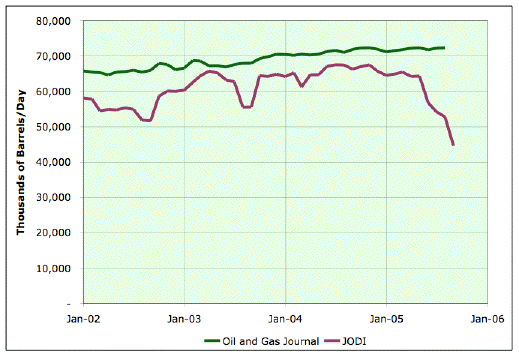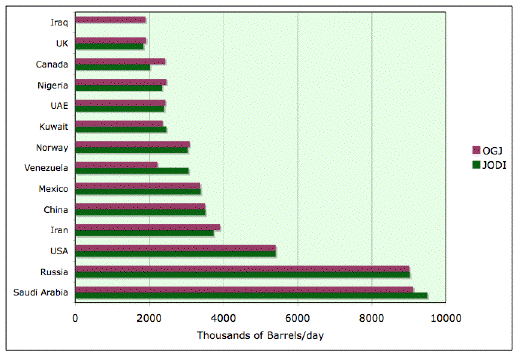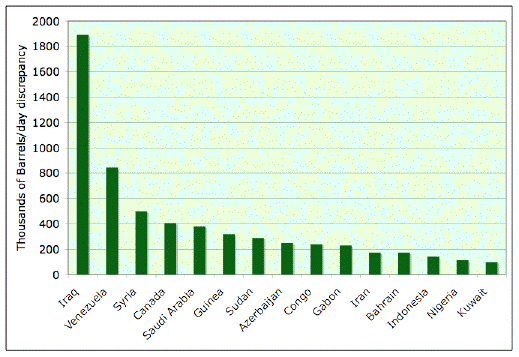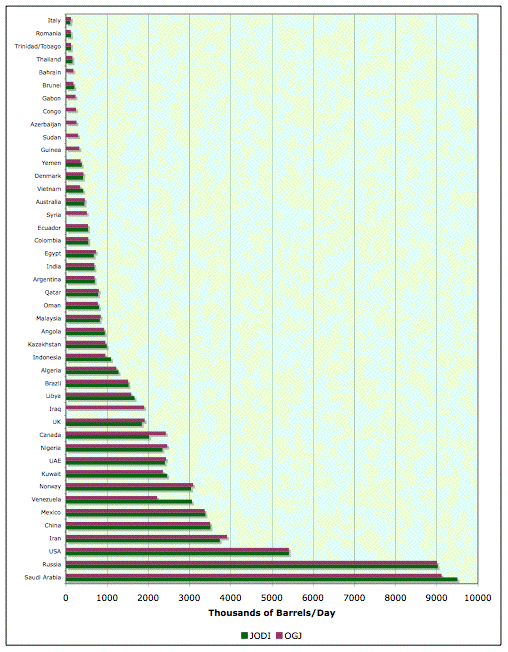JODI Hall of Shame
Posted by Stuart Staniford on November 23, 2005 - 6:04pm

Recent total crude oil production in kbpd (excluding NGL), as estimated by both the Oil and Gas Journal, and the new Joint Oil Data Initiative.
...the seven international organizations behind JODI - APEC, Eurostat, IEA, IEFS, OLADE, OPEC and UNSD - have agreed to open the JODI World Database on the occasion of the inauguration of the IEFS premises on 19 November 2005. This decision was taken with the full knowledge that users might be disappointed, as not all the data for all the flows, products and countries are always available, or of good quality.Indeed, we are disappointed!
Digging in, it's pretty clear that the main problem is missing data, especially late submissions making the last few months extremely unreliable. After poking around a while, I found that July 2004 is the most recent month that has the fewest missing countries. In that month, OGJ reckons production at 71,592kbpd, while JODI has 67,517kbpd. Here are the top producing countries:

July 2004 crude oil production in kbpd (excluding NGL), by top producing countries, as estimated by both the Oil and Gas Journal, and the new Joint Oil Data Initiative. A larger version of this picture with more countries is at the bottom.

Discrepancy between Oil and Gas Journal, and Joint Oil Data Initiative crude production estimates in July 2004 (exclusive of NGL).
Finally, here's the big version of the comparison, for those with good eyes and big screens:

July 2004 crude oil production in kbpd (excluding NGL), by country, as estimated by both the Oil and Gas Journal, and the new Joint Oil Data Initiative. All countries producing more than 100kbpd are shown.




- It shows just how important Saudi Arabia, Russia and Iran (to a leseer extent) are in determining when the peak occurs, and
- funny how Saudi Arabia and Venezuela (the two countries most vocal about their oil production prowess) have over-reported quite considerably in the JODI numbers.
Plenty of mirrors and tricks of the light at JODI!Why is Venuzuala 0 for the last few months?
What the EIA does apparently is extrapolate when data hasn't come in yet. The Joint Data Initiative seems to leave it as 0.
I also notice that the Sep 2005 is down almost exactly 1mbd for the US. Are this Katrina and Rita showing up in the statistics at last?
Which means they can keep prices high to slow world demand in order to extend their production for a few more years. I'd say they are playing the politicians like a violin. I don't think they have what they say they have. They just want to continue being world players. and when the oil runs out, and they are not the biggest producer in the world, so goes their global significance and clout.
It's all one big Chess game.
We can't leave Iraq now or in the foreseeable future unless we're willing to kiss all that oil bye-bye. You don't think? Consider this:
- Iraq is already engaged in a low-grade civil war mediated only by the presence of American troops. As soon as the troops are gone (or substantially reduced) it's going to be real fun and games as Shi'ites, Kurds and Sunnis slug it out in earnest.
- Nobody mentions Turkey anymore because it is a very, very uncomfortable subject. Turkey is trying to be a good Nation playing nice in order to become an EU member. Realpolitik, neanmoins, has a way of trumping good behavior. Turkey will not tolerate an oil-rich quasi-independent Kurdish state across its border. As soon as serious fracture of the Iraqi "federation" takes place (signals: open takeover of the Kirkuk oilfields by Kurd militias and ouster of Baghdad authorities from Kurdish areas) Turkey will fully send its not inconsiderable troops across the border, EU membership be damned. Bonus: those oilfields might end up under Turkish control. Wildcard: will U.S. marines and soldiers engage long-time ally Turkey in combat?
this was all taken from the blogs atkunstler website